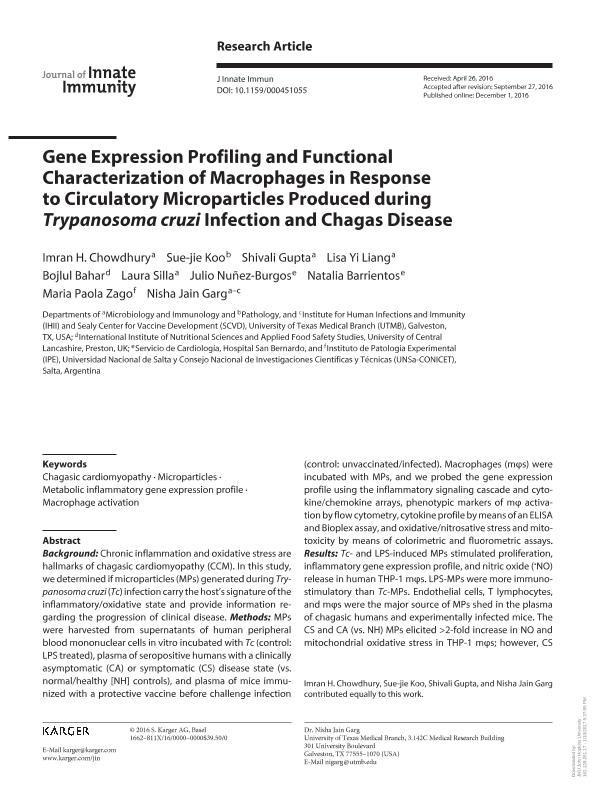Artículo
Gene Expression Profiling and Functional Characterization of Macrophages in Response to Circulatory Microparticles Produced during Trypanosoma cruzi Infection and Chagas Disease
Chowdhury, Imran H; Koo, Sue-jie; Gupta, Shivali; Liang, Lisa Yi; Bahar, Bojlul; Silla, Laura; Nuñez Burgos, Julio; Barrientos, Natalia; Zago, María Paola ; Garg, Nisha Jain
; Garg, Nisha Jain
 ; Garg, Nisha Jain
; Garg, Nisha Jain
Fecha de publicación:
01/12/2016
Editorial:
Karger
Revista:
Journal of Innate Immunity
ISSN:
1662-811X
Idioma:
Inglés
Tipo de recurso:
Artículo publicado
Clasificación temática:
Resumen
Chronic inflammation and oxidative stress are hallmarks of chagasic cardiomyopathy (CCM). In this study, we determined if microparticles (MPs) generated during Trypanosoma cruzi (Tc) infection carry the host?s signature of the inflammatory/oxidative state and provide information regarding the progression of clinical disease. Methods: MPs were harvested from supernatants of human peripheral blood mononuclear cells in vitro incubated with Tc (control: LPS treated), plasma of seropositive humans with a clinically asymptomatic (CA) or symptomatic (CS) disease state (vs. normal/healthy [NH] controls), and plasma of mice immunized with a protective vaccine before challenge infection (control: unvaccinated/infected). Macrophages (mφs) were incubated with MPs, and we probed the gene expression profile using the inflammatory signaling cascade and cytokine/chemokine arrays, phenotypic markers of mφ activation by flow cytometry, cytokine profile by means of an ELISA and Bioplex assay, and oxidative/nitrosative stress and mitotoxicity by means of colorimetric and fluorometric assays. Results: Tc - and LPS-induced MPs stimulated proliferation, inflammatory gene expression profile, and nitric oxide (∙ NO) release in human THP-1 mφs. LPS-MPs were more immunostimulatory than Tc -MPs. Endothelial cells, T lymphocytes, and mφs were the major source of MPs shed in the plasma of chagasic humans and experimentally infected mice. The CS and CA (vs. NH) MPs elicited >2-fold increase in NO and mitochondrial oxidative stress in THP-1 mφs; however, CS(vs. CA) MPs elicited a more pronounced and disease-statespecific inflammatory gene expression profile (IKBKB, NR3C1, and TIRAP vs. CCR4, EGR2, and CCL3), cytokine release (IL-2 + IFN-γ > GCSF), and surface markers of mφ activation (CD14 and CD16). The circulatory MPs of nonvaccinated/infected mice induced 7.5-fold and 40% increases in ∙ NO and IFN-γ production, respectively, while these responses were abolished when RAW264.7 mφs were incubated with circulatory MPs of vaccinated/infected mice. Conclusion: Circulating MPs reflect in vivo levels of an oxidative, nitrosative, and inflammatory state, and have potential utility in evaluating disease severity and the efficacy of vaccines and drug therapies against CCM.
Palabras clave:
Chagasic Cardiomyopathy
,
Microparticles
,
Macrophage Activation
Archivos asociados
Licencia
Identificadores
Colecciones
Articulos(IPE)
Articulos de INST.DE PATOLOGIA EXPERIMENTAL
Articulos de INST.DE PATOLOGIA EXPERIMENTAL
Citación
Chowdhury, Imran H; Koo, Sue-jie; Gupta, Shivali; Liang, Lisa Yi; Bahar, Bojlul; et al.; Gene Expression Profiling and Functional Characterization of Macrophages in Response to Circulatory Microparticles Produced during Trypanosoma cruzi Infection and Chagas Disease; Karger; Journal of Innate Immunity; 9; 2; 1-12-2016; 1-14
Compartir
Altmétricas



